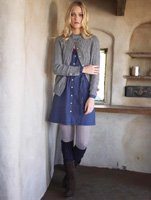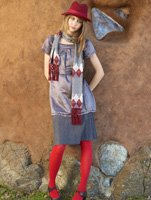Sustainable by Design
Stewart + Brown discuss how to bring sustainability and economic growth to the market
Being a green company is no easy task, especially when you’re torn between the demands of a capitalist economy and the criticism of hardcore environmentalists.
Ventura, Calif.–based Stewart + Brown, founded by the husband-and-wife team of Karen Stewart and Howard Brown, performs a delicate balancing act between market competitiveness and high standards of sustainability.
With design backgrounds at Urban Outfitters, J. Crew and Patagonia, Stewart and Brown launched their own company in 2002 with the desire to shake up the apparel industry. Selling in 350 specialty stores in the United States alone, plus in Europe and Japan, the company is growing in spite of slow economic times because of its commitment to green fashion.
The California Apparel News spoke with Brown about the company’s efforts at “working toward sustainability.”
CAN: So how do you make fashion and save the planet?HB: It’s more about doing your own part. Before we started, there was one real inspiration to us and that was Patagonia, who was proving you could be environmentally responsible and still be serious about business.
So my wife went to work at Patagonia in 1999 to learn how to design in a more sustainable way and learn about environmentally friendly production techniques. So we decided to set an example for others to follow. We aspire to inspire others. CAN: What was your vision for this company as far as sustainability goes?HB: We felt the fashion industry didn’t need another clothing company but needed a green one. We like to say that we’re working toward sustainability. To be truly “sustainable” is pretty much impossible. To us, sustainability means you don’t extract more than you need and you don’t use resources to the detriment of future generations.
The term “sustainable” is a slippery slope. You start preaching when you say you’re sustainable. We do everything we can within reason to achieve our goals. So when we’re evaluating a fabric, we look at where it’s manufactured, how much it costs and the conditions of the farmers. There are so many variables, but, in the end, it’s the design that counts. Because if you can’t sell something, you’re out of business, and if you’re out of business, you’re not sustainable. CAN: Tell us about your cashmere program.HB: We have a cashmere facility where we’re the only company in North America that does all the harvesting, spinning, knitting and dyeing in Mongolia. It’s an effort to keep jobs there.
We pay a little bit more for our production, but we get better quality, and things are made to fair-trade standards and certifications. CAN: How did you set up this facility in Mongolia?HB: I can’t tell you a lot about it because it’s a trade secret, but it was brought to us by a company we have a lot of respect and admiration for.
There are two Mongolias: Inner and Outer. Inner Mongolia is part of China, so when you see Chinese cashmere, it’s really from Inner Mongolia. It’s an environmental disaster what’s going on there with their cashmere production. They’re overgrazing the grasslands, turning them into deserts. A lot of the herds are starving to death. And they’re really screwing up the whole notion of cashmere being a luxury fiber—that’s why you can find so-called cashmere sweaters at Costco for $39. CAN: How much more do you pay?HB: Our cashmere is the best in the world, and most of it is hand-knit, and we pay a high wage for it, so I’d say our costs are at least double. So, our margins are a lot smaller. CAN: What’s the retail price for your cashmere?HB: Accessories are about $80 up to a coat sweater for $1,050. CAN: Do you have a knits program, and where do you source your wool? HB: Knits are a renewable resource because the animals aren’t slaughtered; they’re sheared. Our merino wool is from New Zealand and is the best in the world. It’s free range, so they don’t come from industrial livestock farms where they’re crowded together in unnatural environments. They drink spring water and roam around.
We’ve also had alpaca in the line, and this year we’re introducing yak. That comes from a herder’s co-op in Tibet.CAN: What about your “green fabrics” category?HB: That’s fibers that are grown without the aid of herbicides and pesticides because they’re naturally resistant, like linen. These are also sustainable; for example, with the flax plant, every single part of the plant is used. And the same is true of hemp, as well.
One of the things that is amazing about hemp is that the crop doesn’t take a lot of water, unlike cotton. We think of hemp as something that in the future could become more of a substitute for cotton. But the United States is the only industrialized nation on the planet where it’s illegal to grow hemp. CAN: How does your “surplus” category fit into your collection?HB: That’s where we essentially buy waste fabric from other manufacturers. Fabric warehouses have thousands of yards of leftover fabric that just sit there. So you’re not using more resources in making new fabric.CAN: How does the collection break down by category?HB: About 50 percent of the collection is organic cotton. Cashmere is 20 percent, and the balance is merino wool, green fabrics and surplus. CAN: Your Web site includes such details as how the merino-wool sheep are fed. How important are these things to your consumer?HB: For some people—I’d say half—it’s really important. We hope people buy our stuff because they like the designs [and because] it has a good hand and a good fit at the right price. But over the past few years, we’ve seen the number of people interested in purchasing “sustainable” products really increase.CAN: Since you were already thinking about this in the early ’90s, what do you make of the current green trend in the apparel industry?HB: In general, it’s a great and necessary thing. But I think there a lot of people who are insincere about it. I think there’s a lot of opportunism going on. I also think that’s not healthy for the industry because it’s causing some consumer confusion, and that’s probably part of the goal of these people. They want to get off easy, and this isn’t an easy thing to do. It’s a real commitment.
The good thing is that hopefully the demand will drive volume and bring down the prices on some of these commodities. I think it has changed the industry for the better, long-term. CAN: How are you doing in the current economy?HB: We finished the first half of the year up 25 percent. If it weren’t for the economic downturn, we’d probably be up 65 or 70 percent, like we were before the first of the year. CAN: Brands aspiring to be sustainable primarily seem to target the higher end of the market. HB: The reason is our costs are high. We don’t do bulk volume. The smaller you are, the further to the back of the line you get pushed. That’s the nature of economics.
Also, the reason you’re finding a lot of people moving into this category and targeting better stores is because there’s a lot of excitement for designers in doing things this way. Designers are creative people, and I’d say by and large they probably want to do the right thing, and this is a new, exciting frontier. CAN: What other efforts are you making around the office?HB: I get asked this a lot, and people expect me to say, “We drive Priuses, we walk to work, we’ve got solar panels on the ceiling and we drink rain water.” No, we don’t.
We have some skylights in the office so we don’t have to turn on the lights, we recycle, we have a little garden in the back, and we have no heater or air-conditioning, and our office is full of used furniture.
We’re in an old building that used to be a lawnmower repair shop, and we didn’t paint the outside of the building. CAN: What can other companies learn from you?HB: I think there’s a tremendous amount of waste in this industry. I hope what the bigger guys can learn is that they’re really the ones who have the leverage to make their factories change. And they need to know that being green, or working toward sustainable, or being good stewards of the environment, or having responsible business practices is good business and consumers like that. And it’s worth it as an investment in the future.
Patagonia, a medium-sized company, has shown that they can do it, and Stewart + Brown, a small company, can do it, so anybody can do it. You really have no excuse. And if Wal-Mart can supposedly do it, then there you have it: from the smallest company to the biggest behemoth in retail. CAN: When you’re a green company, you get a lot of criticism from people who think you’re not green enough. HB: I get angry e-mails from people I call the “militant vegans.” One time a woman goes: “I really like what you guys are doing, and I’d like to buy some of your cashmere, but I need to know before I make my purchase: When the animals are past their prime, are they slaughtered for meat?” I said, “Absolutely,” and this woman just went off on a tirade.
Look, the Mongolians lead a more sustainable life than anybody I know. And by the way, go to Mongolia and try ordering a salad. All they eat is meat. And you can’t pass your enlightened, 21st-century values on a culture that probably actually does a lot less destruction to the natural world than we do.
That’s why we try not to be on a soapbox. We’re realistic. I’m wearing leather shoes, and I’m okay with it. We’re the first ones to say we’re not perfect.
We’re trying to be, but we know it’s an impossible goal.
























